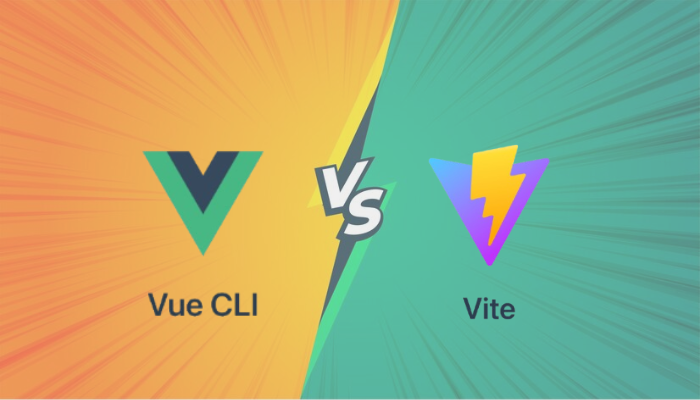The Battle of Build Tools: Vue CLI vs Vite
 Maitri Patel
Maitri Patel
Welcome to the Battle of Build Tools: Vue CLI vs Vite! 🥊 Do you want to advance your Vue.js development? In this showdown, we’ll compare the powerful, feature-rich Vue CLI with the sleek, lightning-fast Vite. Join us as we compare their strengths, use cases, and unique features to help you decide which tool best fits your development needs.
What is Vite?
Vite is a modern development server and build tool for quick front-end development. It uses native ES modules to replace hot modules and fast loading, allowing instant browser updates without requiring complete reloads. Vite supports multiple frameworks, including Vue, React, and Svelte, and provides optimized production builds using Rollup. Its ecosystem of plugins and adaptable setups improves efficiency and performance by streamlining the development process, making it a wise choice to hire Vite js developer to optimize your projects.
What is Vue CLI?
Vue CLI, a command-line interface for Vue.js, streamlines development by offering resources for creating, maintaining, and launching Vue apps. Its pre-configured choices include support for state management, routing, and current JavaScript features, so developers can swiftly scaffold new projects. The Vue CLI streamlines the process and increases productivity when working with Vue.js making it simple to run development servers, manage dependencies, and install plugins.
Vue CLI vs Vite: Comparision
The main distinctions between Vue CLI vs Vite are shown in the following comparison table:
Aspects | Vue CLI | Vite |
Development speed | Slower | Faster |
Supported Framework | Primarily Vue | Vue, React, etc. |
Production Builds | Webpacked optimised | Rollup optimised |
Configuration | More complex | More Straightforward |
Scaffolding | Project templates available | Quick project setup with templates |
Ecosystem | Well established | Expanding |
Learning Curve | More challenging due to its complexity | More straightforward and user-friendly |
Explanation:
Development speed
Vue CLI takes longer to develop than Vite since it depends on Webpack for bundling, which gathers the entire application before delivering it. This may result in more extended build times, particularly for larger projects. Vite, on the other hand, uses native ES modules, which allow for quicker hot module replacement (HMR) and immediate server starts by only reloading the modules that change. Because of this simplified process, Vite can offer a more rapid and effective development experience.Supported Framework The Vue CLI focuses on Vue.js apps and provides tools and options especially designed for Vue development. Vite, on the other hand, is a more flexible option for developers working with various technologies because it supports several frameworks, including Vue, React, and others. Because of its adaptability, Vite can serve a broader range of users, making it more straightforward for projects that use different front-end frameworks.
Production Builds Vue CLI leverages Webpack for production builds, which optimizes the application by effectively analyzing and bundling all assets, potentially producing reliable and optimized output. Conversely, Vite uses Rollup for its production builds, emphasizing tree-shaking and performance-enhancing optimization for reduced bundle sizes. Although both tools provide optimized builds due to the variations in bundling methods, Vite's method with Rollup frequently leads to faster load speeds.
Configuration Vue CLI has so many choices and plugins designed explicitly for Vue development it usually requires more complicated configuration, which can occasionally be burdensome for developers, especially those unfamiliar with the tool. However, Vite prioritizes usability and simplicity by providing a more straightforward configuration approach. Because of this, developers can get started more quickly and with less boilerplate, which makes Vite a more approachable option for projects that need less effort and setup time.
Scaffolding To facilitate the process of implementing best practices, Vue CLI provides a number of project templates for scaffolding Vue applications with predetermined parameters. On the other hand, Vite emphasizes speed and ease of use by offering templates for quick project setup across several frameworks, enabling developers to start projects quickly and effectively across various technologies.
Ecosystem Vue CLI has a well-established ecosystem with a wide range of plugins and community resources, making it a reliable choice for Vue developers. In contrast, as Vite becomes more well-known, its ecosystem grows quickly, drawing in additional plugins and community support for a broader range of frameworks.
Learning Curve The complexity and wide range of configuration options of Vue CLI make it more difficult for new programmers to master. In contrast, Vite is made to be simpler and easier to use, so developers can rapidly understand its principles and begin creating apps with less setup.
Use Cases of Vue CLI and Vite
Here is a breakdown of project types where each tool is utilized:
Vue CLI use cases-
Enterprise Projects
Personalised Webpack Setups
Large-Scale Vue Projects
Vite use cases-
Starting New vue projects
Modern web apps
Cross frameworks development
Conclusion
As we wrap up our exploration of Vue CLI vs Vite, it's time to engage! Reflect on your own projects: Do you prioritize the robust ecosystem and extensive configurations of Vue CLI, or do you lean towards the speed and simplicity that Vite offers? If you're still undecided, don’t hesitate to contact a Vuejs development company to help you review these choices and decide which is ideal for your projects.
Whether you choose Vue CLI or Vite, the right build tool can significantly enhance your development experience. Let’s continue to learn and grow together in this ever-evolving field!
Subscribe to my newsletter
Read articles from Maitri Patel directly inside your inbox. Subscribe to the newsletter, and don't miss out.
Written by

Maitri Patel
Maitri Patel
Greetings, tech enthusiasts! I'm an expert in creating informative content to navigate the dynamic tech landscape. Join me as we uncover the latest advancements together!